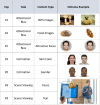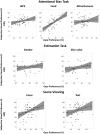Do we know our visual preferences?
- PMID: 36799868
- PMCID: PMC9942782
- DOI: 10.1167/jov.23.2.9
Do we know our visual preferences?
Abstract
Humans differ in the amount of time they direct their gaze toward different types of stimuli. Individuals' preferences are known to be reliable and can predict various cognitive and affective processes. However, it remains unclear whether humans are aware of their visual gaze preferences and are able to report it. In this study, across three different tasks and without prior warning, participants were asked to estimate the amount of time they had looked at a certain visual content (e.g., faces or texts) at the end of each experiment. The findings show that people can report accurately their visual gaze preferences. The implications are discussed in the context of visual perception, metacognition, and the development of applied diagnostic tools based on eye tracking.
Figures



References
-
- Bradley, B. P., Mogg, K., Millar, N., Bonham-Carter, C., Fergusson, E., Jenkins, J., et al. (1997). Attentional biases for emotional faces. Cognition & Emotion, 11(1), 25–42, 10.1080/026999397380014. - DOI
-
- Byrne, A. (2005). Introspection. Philosophical Topics, 33(1), 79–104.
-
- Celebi, F. M., Kim, E. S., Wang, Q., Wall, C. A., & Shic, F. (2014). A smooth pursuit calibration technique. Proceedings of the Symposium on Eye Tracking Research and Applications, 377–378, ETRA conference 2000, 10.1145/2578153.2583042. - DOI
Publication types
MeSH terms
LinkOut - more resources
Full Text Sources

